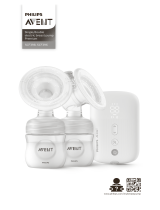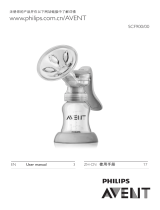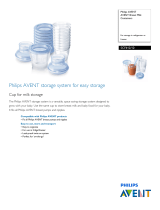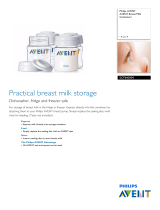
2.
42133 5411 870
www.philips.com/AVENT
Philips AVENT, a business of Philips Electronics UK Ltd.
Philips Centre, Guildford Business Park, Guildford, Surrey, GU2 8XH
Trademarks owned by the Philips Group.
© Koninklijke Philips Electronics N.V. All Rights Reserved.
Manual Breast Pump
Laktator Ręczny
Ручной Молокоотсос
Ručna izdajalica
GB
PL
RU
HR
b
k
a
c
d
e
h
i
l
j
m
n
f
l
g
or
lub
или
Ili
Manual Breast PumpManual Breast Pump
Laktator RęcznyLaktator Ręczny
0%
BPA
0%
BPA
BPA is Bisphenol-A. This product uses Polyethersulfone (PES),
which is BPA-Free and has a natural honey-coloured tint.
BPA – это Бисфенол-А. Данный молокоотсос произведен из
полиэфирсульфона, не содержащего бисфенол-А, что придает
молокоотсосу легкий медовый оттенок.
BPA oznacza Bisfenol A. W tym produkcie zastosowano polieterosulfon (PES),
który nie zawiera BPA i posiada naturalne żółtawe zabarwienie.
BPA je bisfenol A. Ovaj proizvod koristi polietersulfon (PES) koji ne sadrži
BPA i ima prirodnu tintu boje meda.
Call FREE on
0800 289 064 (GB Only)
Call FREE on
1800 509 021 (IRL Only)
Call on
1 300 364 474 (AUS)
LAKTATOR JEST URZĄDZENIEM HIGIENICZNYM,
NIE PODLEGA WYMIANIE, ANI ZWROTOWI
W przypadku problemów w czasie użytkowania laktatora prosimy
dzwonić do biura firmy Krotex-Poland; Dystrybutor w Polsce:
Krotex-Poland Sp. z o.o. ul. Rydygiera 8, 01-793 Warszawa
Tel: 0 801 35 37 37
Oфициальный дистрибьютор в России ОЛТРИ Tpeйдинг
тел. 8-800-200-22-29
Želite li znati više o našim proizvodima, možda neki savjet ili
želite da Vam pošaljemo katalog nazovite nas na broj telefona:
01/333 66 96
Uvoznik: Kadulja A.M. d.o.o.
A.Hebranga 52, 10430 SAMOBOR
GB
PL
RU
HR

14.
Ostali proizvodi za uspješno dojenje
iz programa Philips AVENT
AVENT Ultra Comfort prsne blazinice
za jednokratnu upotrebu – jedinstvene
ULTRA upijajuće blazinice garantiraju
potpunu suhoću i ugodnost
AVENT prsne školjke (2 para) sa
mekanom stražnjom silikonskom
prevlakom – za zaštitu ispucanih i bolnih
bradavica, pomaže kod prenapunjenih
dojki i u prikupljanu mlijeka koje curi
AVENT štitnici za bradavice –
za zaštitu ispucanih i bolnih bradavica
tijekom dojenja (u maloj i standardnoj
veličini)
HR
6. (1) – (7)
IMPORTANT: DO NOT LOSE THE WHITE VALVE. YOUR PUMP
WILL NOT WORK WITHOUT IT OR IF IT IS FITTED INCORRECTLY.
If lost, spare valves are available direct from Philips AVENT.
ВНИМАНИЕ! При утeрe или нeправильной установкe клапана
насоса работа молокоотсоса нeвозможна! При утере клапана
вы можете приобрести новый в сервисном центре Philips AVENT.
AVENT VIA posudice za pohranu mlijeka –
za pohranu i transport izdojenog mlijeka
AVENT bočice za pohranu mlijeka –
Za pohranu mlijeka ili dječje hrane u
hladnjaku ili zamrzivaču
GB
Contents
1. Introducing the Manual Breast Pump
2. Detailed parts guide
3. Cleaning and sterilisation
4. Keeping your breast pump sterile for travel
5. Using the Manual Breast Pump with the
AVENT VIA Storage System
6. How to assemble the Manual Breast Pump
7. When to express milk
8. Hints to help you succeed
9. How to use the Manual Breast Pump
10. Storing your breast milk
11. Feeding your baby your expressed breast milk
12. Choosing the right teat for your baby
13. Troubleshooting guide
14. Other helpful products from Philips AVENT
Please take five minutes to read through the WHOLE
of this leaflet BEFORE you use your Philips AVENT
Manual Breast Pump for the first time.
Should you ever lose these instructions, they are available
on our website: www.philips.com/AVENT
or/lub/или/Ili or/lub/или/Ili
or/lub/или/Ili or/lub/или/Ili
45
Philips AVENT komplet za izdajanje
u torbi Komplet za izdajanje – za izdajanje
i transport izdojenog mlijeka
UWAGA: BIAŁY ZAWÓR NALEŻY PRZECHOWYWAĆ
W BEZPIECZNYM MIEJSCU. LAKTATOR NIE BĘDZIE
DZIAŁAĆ BES ZAWORU (LUB GDY ZAWÓR ZOSTANIE
NIEPRAWIDŁOWO ZAMOCOWANY). W przypadku jego
zgubienia zapasowe zawory mo
ż
na nabyć bezpośrednio
w firmie Philips AVENT.
VAŽNO: BIJELI VENTIL NE SMIJETE IZGUBITI. VAŠA IZDAJALICA
NEĆE RADITI AKO NEMA BIJELOG VENTILA ILI JE ON NEPRAVILNO
POLOŽEN. Ukoliko ga ipak izgubite, rezervni dio moguće je naručiti na
broj telefona : 01 33 69 520, e-mail: [email protected]

1
GB
1. Introducing the Manual Breast Pump
The Manual Breast Pump is a breakthrough in breast pump design.
Its silicone diaphragm provides 100% reliable vacuum, whilst the
Let-down Massage Cushion naturally imitates your baby’s suckling
action to provide fast milk flow – silently, comfortably and gently.
The pump is easy to assemble, discreet to use and all parts are
dishwasher safe.
Doctors recommend that breast milk is the best nutrition for babies
during the first year, combined with solid food after the first 6
months. Your milk is specially adapted to your baby’s needs and
contains antibodies which help protect your baby against infection
and allergies.
Your Manual Breast Pump will help you breastfeed longer. You can
express and store your milk so that – whether you are out for a few
hours, taking a well deserved rest, or back at work – your baby can
still enjoy the benefits of your breast milk, even if you can’t be there
to give it yourself. As the pump is so silent and discreet you can take
it with you anywhere, allowing you to express milk at your own
convenience and maintain your milk supply.
Since the AVENT Bottle and AVENT Teat are specially designed to
mimic breastfeeding, your baby will switch easily between breast
and bottle. This allows mothers to continue providing breast milk
to baby even when they return to work.

2
2. Detailed parts guide
MANUAL BREAST PUMP
a) Funnel cover (same as i)
b) Let-down Massage Cushion
c) Pump cover
d) Silicone diaphragm
and stem*
e) Handle
f) Pump body
g) White valve*
3. Cleaning and sterilisation
Before you use your breast pump for the
fi
rst time and every time before use:
Separate all parts, then wash in the dishwasher or in warm soapy
water and rinse. Do not use antibacterial or abrasive cleaners/
detergents. Sterilise in a Philips AVENT Steam Steriliser (Digital,
Electric or Microwave), or by boiling for 5 minutes. If using a Philips
AVENT Steam Steriliser, the pump will remain sterile in the steriliser
for a minimum of 6 hours, provided the lid is not
removed.
4.
Keeping your breast pump sterile for travel
After sterilising all parts, insert the white valve (g) and
fit the diaphragm with stem (d) onto the pump body (f).
Clip the cover (a) over the funnel and Let-down Massage
Cushion (b) and screw on the sealing base (m) in place of
the AVENT Feeding Bottle (h).
GB
BOTTLE
h) AVENT Feeding Bottle (125ml/4oz)
i) Stand (same as a)
j) Dome cap
k) Extra Soft Teat, Newborn Flow (0m+)
l) Screw ring
m) Sealing base
n) Sealing disc
*spares included
3
GB
5
.
Using the Manual Breast Pump
with the AVENT VIA Feeding System
Simply replace the AVENT Feeding Bottle with a VIA
Cup and Adaptor. To make the pump completely
stable insert the VIA Cup into the VIA Lid/Stand.
6. How to assemble the Manual
Breast Pump
Separate all parts and ensure pump has been cleaned
and sterilised as in section 3:
1) Wash your hands thoroughly. Insert the white valve (g) into the pump
body (f) from underneath
.
2)
Place the pump body (f) onto the AVENT Feeding Bottle (h).
3)
Twist gently clockwise until secure. DO NOT OVERTIGHTEN!
4)
Place the silicone diaphragm and stem (d) into the pump body (f). Make
sure it
fi
ts securely around the rim by pressing down with your
fi
ngers
to ensure a perfect seal. (This is easier if assembled whilst wet.)
5)
Place the forked end of the handle (e) under the silicone diaphragm
and stem (d) and push down gently on the handle until it clicks into
place.
6)
Carefully insert the Let-down Massage Cushion (b) into the pump
funnel (f) making sure it is perfectly sealed all round the rim of the
funnel. (This is easier if assembled whilst wet.)
7)
Click the pump cover (c) onto the pump body (f). To make the pump
completely stable insert the bottle into the stand (i).
7. When to express milk
1) If possible, wait until your milk supply and breastfeeding schedule are
well established, normally at least 2-4 weeks after birth, unless told
otherwise by your health professional or breastfeeding advisor.

4
GB
2) The exceptions to the above are:
a) If you are expressing milk for your baby to be given in hospital.
b) If your breasts are engorged (painful or swollen), you can express
a small amount of milk before or between feeds to ease the pain
and to help your baby latch on more easily.
c) If you have sore or cracked nipples, you may wish to express your
milk until they are healed.
d) If you are separated from your baby and wish to continue to
breastfeed when you are reunited, you should express your milk
regularly to stimulate your milk supply.
3) You will need to find the right times of the day for you to express
your milk, e.g.
a) Early in the morning when your breasts are full, just before or
after your baby’s first feed.
b) After a feed, if your baby has not emptied both breasts.
c) Between feeds, or in a break if you have returned to work.
8. Hints to help you succeed
Using a breast pump takes practice – you may need to make several
attempts before you succeed, but because the pump is so simple and
natural to use, you will soon get used to expressing your milk.
1) Choose a time when you’re not rushed and won’t be interrupted.
2) Having your baby or a photograph of your baby nearby can help
encourage ‘let-down’.
3) Placing a warm cloth on the breasts for a few minutes before you
start pumping can encourage milk flow and soothe painful breasts.
4) Warmth and relaxation can encourage milk flow. Try expressing after
a bath or shower.
5) Try expressing from one breast while your baby is feeding from the
other, or continue expressing just after a feed.
5
GB
6) Repositioning the pump on the breast from time to time can help
stimulate your milk ducts.
Practice with your pump to find the best technique for you.
However, if the process becomes very painful, stop and consult
your breastfeeding advisor.
9. How to use the Manual Breast Pump
1) Wash your hands thoroughly and make sure your breasts are clean.
Gently squeeze a little milk from each nipple to ensure milk ducts are
not blocked.
2) Make sure you have sterilised and carefully assembled your pump
exactly as shown in sections 3 and 6.
3) Consult the ‘Hints to help you succeed’ section.
4) Relax in a comfortable chair, leaning slightly forward (use cushions
to support your back). Make sure you have a glass of water nearby.
5) Press the funnel and Let-down Massage Cushion of the pump firmly
against your breast, making sure that no air can escape – otherwise
there will be no suction.
6) As you gently push down on the pump handle, you will feel the
suction on your breast. You don’t need to depress the handle fully
to create a vacuum – only as much as is comfortable. Your milk will
soon start flowing, even though you may not use all the suction the
pump can generate.
7) Begin by pumping 5-6 times rapidly to initiate let-down. Then, hold the
handle down for 2-3 seconds, and allow it to return to its resting place.
These 2-3 second cycles imitate your baby’s natural suckling pattern
and allow the milk to flow between strokes.
8) Milk should begin to flow after the first few strokes. Don’t worry if
your milk does not flow immediately. Relax and continue pumping.
Do not continue pumping for more than 5 minutes at a time if
NO result is achieved. Try expressing at another time during the day.

6
GB
Please remember that, should the process become very painful or
uncomfortable, you should stop using the pump and consult your
health professional or breastfeeding advisor.
9) Whilst some women may prefer to use the pump without the Let-down
Massage Cushion, extensive trials show that, in most cases, the
massaging effect of the petals flexing in and out around the areola
stimulates the let-down reflex and allows you to express more milk, faster.
10) On average you will need to pump for 10 minutes to express 60-125ml
or 2-4oz. However, this is just a guide and varies from woman to woman.
If you find that you regularly express more than 125ml/4oz per session,
please use a 260ml/9oz AVENT Bottle or 240ml/8oz VIA Cup.
Do not overfill AVENT Feeding Bottles or VIA Cups and keep upright,
otherwise milk may leak from below the pump body.
10. Storing your breast milk
• Breastmilkcanbestoredin
the fridge or freezer in either
sterile breast milk containers
(125ml/4oz or 260ml/9oz
bottles fitted with sealing discs)
or in VIA Cups with Lids.
• Onlymilkcollectedwithasterilepumpshouldbestoredtobefedto
your baby.
• Expressedmilkshouldberefrigeratedimmediately.
• Expressedbreastmilkcanbestoredintherefrigeratorforupto
48 hours (not in the door) or in the freezer for up to 3 months.
• Ifyouarestoringmilkinthefridgetoaddtoduringtheday,onlyadd
milk which has been expressed into a sterile container. Milk can only
be kept like this for a maximum of 48 hours (from first expression)
after which it must be used immediately or frozen for future use.
• Forproductsotherthanbreastmilkmakefeedsupfreshwhenneeded,
following the manufacturer’s instructions.
Storing your milk in the fridge
If your expressed breast milk will be fed to your baby within 48 hours,
it can be stored in the fridge (not in the door) in an assembled AVENT
7
GB
Feeding Bottle or VIA Feeding System. Assemble a sterilised teat,
screw ring and dome cap and attach onto the body of the AVENT
Bottle or the VIA Adaptor and Cup (see below).
Storing your milk in the freezer
To store in the freezer, use a sealing disc in place of the teat and
dome cap or use a sterilised VIA Lid to seal the VIA Cup. The storage
containers should be clearly labelled with the date and time of
expression and older milk used up first.
NEVER refreeze breast milk. DO NOT add fresh breast milk to already
frozen milk. ALWAYS discard any milk that is left over at the end of a feed.
11. Feeding your baby your expressed breast milk
If breast milk has been stored in an AVENT Breast Milk
Container, replace the sealing disc with a sterilised
AVENT Teat.
Alternatively replace the VIA Lid with a sterilised VIA
Adaptor, screw ring, dome cap and AVENT Teat.
Frozen breast milk should be defrosted overnight in the
refrigerator. However, in an emergency, it can be defrosted
in a jug of hot water. Once thawed use within 24 hours.
Breast milk can be heated in the same way as any other bottle feed.
Stand the AVENT Bottle or VIA Feeding System in a bowl of hot water,
or alternatively, for a safe and fast way to warm feeds, use the Philips
AVENT Bottle and Baby Food Warmer. IMPORTANT! Milk or food will
heat faster in VIA Cups than in standard feeding bottles/containers.
Always check milk or food temperature before feeding.
Never heat milk in a microwave as this may destroy valuable nutrients
and antibodies. In addition, the uneven heating may cause hot spots
in the liquid which could cause burns to the throat.
Never immerse a frozen milk container or VIA Cup in boiling water as
this may cause it to crack/split.
Never put boiling water directly into a VIA Cup, allow to cool for
around 20 minutes before filling.

GB
12. Choosing the right teat for your baby
AVENT Teats can be used on both the AVENT Feeding Bottle and VIA
Feeding System. AVENT Teats are clearly numbered on the side to
indicate flow rate.
8
1
3
2
4
0
m
+
6
m
+
1m
+
3
m
+
3
m
+
1 hole
2 holes
3 holes
4 holes
1 slot
NEWBORN FLOW
EXTRA SOFT SILICONE TEAT
Ideal for newborns and breastfed
babies of all ages.
SLOW FLOW
EXTRA SOFT SILICONE TEAT
Ideal for newborns and breastfed
babies of all ages.
MEDIUM FLOW
SOFT SILICONE TEAT
For bottle fed babies at 3 months
of age and up.
FAST FLOW
SOFT SILICONE TEAT
Offers a faster flow for older babies.
VARIABLE FLOW
SOFT SILICONE TEAT – SLOT CUT
Provides an extra fast flow and
accommodates thicker liquids.
Flow rate can be varied by turning
the bottle to align the I, II or III markings
on the teat with baby’s nose.
GB
9
13. Troubleshooting guide
Lack of suction
No milk being expressed
Pain in the breast area
when expressing
Milk is drawn up the
Let-down Massage Cushion
Cracking/discolouration of
pump parts
Lost or broken parts
Check that all the pump components have been
assembled correctly and that the white valve is the right
way up. Ensure that the diaphragm and Let-down Massage
Cushion are fitted securely to the pump body and a perfect
seal is created.
Ensure suction is created and the pump is correctly
assembled. Relax and try again, expression may improve
after practice. Please refer to the ‘Hints to help you
succeed’ section.
You may be pumping too hard. You do not need to use
all the suction the pump can generate. Try depressing
the handle halfway and remember the 2-3 second
pumping rhythm. Consult your health professional/
breastfeeding advisor.
Remove and refit the Let-down Massage Cushion
ensuring it is firmly attached and pushed far enough
down the funnel. Try leaning slightly forward.
Avoid contact with antibacterial or abrasive detergents/
cleaners as these can damage the plastic. Combinations
of detergents, cleaning products, sterilising solution,
softened water and temperature fluctuations may, under
certain circumstances, cause the plastic to crack. If this
occurs, do not use. Contact Philips AVENT Customer
Services for spare parts. The pump is dishwasher safe
but food colourings may discolour components.
Spare parts are available through Philips AVENT Customer
Services (see back cover for contact details)
If you are still experiencing problems, please contact Philips AVENT Customer
Services. (see back cover for contact details). Alternatively contact your health
professional/breastfeeding advisor.

PL
Spis treści
1. Laktator ręczny
2. Szczegółowy wykaz części
3. Mycie i sterylizacja
4. Zachowanie sterylności laktatora podczas podróży
5. Używanie laktatora ręcznego z systemem karmienia AVENT VIA
6. W jaki sposób składać laktator ręczny
7. Kiedy odciągać mleko
8. Przydatne wskazówki
9. Jak używać laktatora ręcznego
10. Przechowywanie odciągniętego mleka
11. Karmienie dziecka odciągniętym mlekiem
12. Wybór odpowiedniego smoczka dla dziecka
13. Rozwiązywanie problemów
14. Inne produkty Philips AVENT do karmienia piersią
PRZED pierwszym użyciem Laktatora Philips AVENT
należy poświęcić pięć minut na uważne przeczytanie
CAŁEJ ulotki.
W przypadku zagubienia niniejszej broszury, instrukcje
w niej przedstawione można znaleźć na naszej stronie
internetowej: www.philips.com/AVENT
11
GB
14. Other helpful products from Philips AVENT
AVENT Breast Shell Set (2 pairs)
with Ultrasoft Backing Cushion –
to protect sore/cracked nipples,
help ease engorgement and
collect leaking breast milk.
AVENT Nipple Protectors –
to protect sore/cracked nipples
during breastfeeding (small and
standard sizes).
AVENT Breast Milk/Baby Food Containers –
for storage of breast milk or baby food
in the fridge or freezer.
AVENT VIA Breast Milk Containers –
for expressed milk storage and transport.
AVENT Ultra Comfort Disposable
Breast Pads – unique ULTRA
absorbent core guarantees total
dryness and comfort.
10
Philips AVENT Out & About Manual
Breast Pump Set – for expressing and
transporting breast milk.
Page is loading ...
Page is loading ...
Page is loading ...
Page is loading ...
Page is loading ...
Page is loading ...
Page is loading ...
Page is loading ...
Page is loading ...
Page is loading ...
Page is loading ...
Page is loading ...
Page is loading ...
Page is loading ...
Page is loading ...
Page is loading ...
Page is loading ...
-
 1
1
-
 2
2
-
 3
3
-
 4
4
-
 5
5
-
 6
6
-
 7
7
-
 8
8
-
 9
9
-
 10
10
-
 11
11
-
 12
12
-
 13
13
-
 14
14
-
 15
15
-
 16
16
-
 17
17
-
 18
18
-
 19
19
-
 20
20
-
 21
21
-
 22
22
-
 23
23
-
 24
24
-
 25
25
Avent SCD241/00 User manual
- Category
- Breast pumps
- Type
- User manual
Ask a question and I''ll find the answer in the document
Finding information in a document is now easier with AI
in other languages
Related papers
Other documents
-
 Philips AVENT SCF396/11 électrique Owner's manual
Philips AVENT SCF396/11 électrique Owner's manual
-
 Philips AVENT SCF900/00 User manual
Philips AVENT SCF900/00 User manual
-
 Philips AVENT SCF612/99 Datasheet
Philips AVENT SCF612/99 Datasheet
-
Philips SCF398 User manual
-
Philips SCF332/31 Single electric breast pump User manual
-
Philips SCF614/10 User manual
-
baby express BE MINI X User guide
-
 Philips AVENT SCF640/04 Datasheet
Philips AVENT SCF640/04 Datasheet
-
Philips Avent SCF640/04 User manual
-
Philips SCF640/05 User manual






























